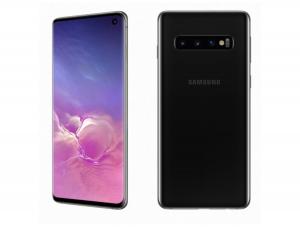What is a Dynamic AMOLED display?
OLED displays offer the best quality images and the freedom of flexible design. OLEDs have become very popular in high-end smartphones in recent years, with companies such as Samsung, Apple, Huawei, Xiaomi and others all releasing OLED smartphones.

For many years, Samsung branded its smartphone OLEDs as Super AMOLED displays. These AMOLED displays have an integrated touch layer, offer an extremely high image quality and are generally considered to be the world's best mobile displays.
In 2019, when Samsung introduced its Galaxy S10 family of smartphones, it introduced a new display technology it calls Dynamic AMOLED. A few years later, the company updated these displays which are now branded as Dynamic AMOLED 2X, which increases the refresh rate to 120Hz (up from 60Hz).
What is a Dynamic AMOLED?
In short, a Dynamic AMOLED display is a Super AMOLED display with an added HDR10+ support. Samsung says that these next-generation OLED display panels includes "HDR10+ certification for cinema-grade color and contrast" - Mobile Color Volume 100% of DCI-P3 (Digital Cinema Initiatives) coverage with a contrast ratio of 2,000,000:1, certified by VDE Germany.

Dynamic AMOLED displays have also received eye comfort certification from TUV Rheinland. Based on the lower blue light emission of the OLED displays, they are safer to use compared to other displays (LCDs) on the market.
As we said below, the latest Dynamic AMOLED 2X increases the refresh rate to 120Hz.
Dynamic AMOLED vs Super AMOLED
Many people wonder what is the actual difference between a Dynamic AMOLED and a Super AMOLED. Samsung is not very clear about this, and it continues to use both brands for its display products. It is most likely that a Dynamic AMOLED is a Super AMOLED with HDR10+ certification.
So what are Infinity-O Displays?
Samsung Galaxy S10 smartphones adopted what Samsung called an Infinity-O Display. This term was used by Samsung to note that the display covered the entire from of the device, with a hole cut for the camera. This is to distinguish this design from notch-type OLEDs such as these used by Apple in its iPhones at the time. Today Samsung no longer uses the Infinity-O Display brand.
Samsung announces the Galaxy Fold3 and Flip3 foldable phones, and new smartwatches
Samsung announced several new OLED devices, including its two new foldable smartphones. First up is the Galaxy Z Fold3, which features a 7.6-inch 1768x2208 120Hz 1200 nits foldable Dynamic AMOLED X2 display, and a 6.2-inch 120Hz 832x2268 external AMOLED display. The foldable phone sports Samsung's first under-the-display selfie camera.

Samsung says that the new Galaxy Fold has an improved hinge design and is more durable compared to previous generation devices. The second phone is the Galaxy Flip3, which features a 6.7-inch 120Hz 1200 nits 1080x2640 foldable Dynamic AMOLED display, and an external 1.9" 260x512 Super AMOLED display.
Samsung releases a nice infographic describing the advantages of its latest AMOLED display
A couple of weeks ago Samsung announced its latest flagship phone, the Galaxy Note 10, with its 6.3" 2280x1080, 401 PPI, Dynamic Infinity-O AMOLED display (6.8" 3040x1440, 498 PPI, on the Note 10+). The company released this nice infographic that details the new AMOLED display (click on it to see a larger version):
DisplayMate tested the new display, and says that this is the world's best smartphone display. The Note 10+ OLED sets 13 new display performance records - including the world's highest absolute color accuracy and highest peak brightness (at 1,308 nits).
Samsung says pre-orders for the Galaxy Note 10 already passed 1.3 million in Korea
Samsung's will start shipping the Galaxy Note 10 in a couple of days, but the smartphone is available for pre-orders and Samsung announced that pre-orders in Korea alone already passed 1.3 million. This is double the pre-orders of last year's Galaxy Note 9.

The most popular model in Korea is currently the 256Gb Galaxy Note 10+. The Note 10 features a 6.3" 2280x1080, 401 PPI, Dynamic Infinity-O AMOLED display (6.8" 3040x1440, 498 PPI, on the Note 10+) with an under-the-display fingerprint sensor. Displaymate says that this is the world's best smartphone display ever.
DisplayMate: Samsung's Galaxy Note 10+ AMOLED is the world's best smartphone display
DisplayMate tested Samsung's latest OLED flagship phone, the Galaxy Note 10+, and (as expected) says that this is the world's best smartphone display. DisplayMate says that the Note 10+ sets 13 new display performance records - including the world's highest absolute color accuracy and highest peak brightness (at 1,308 nits).

Other records set by the Note 10+ Dynamic AMOLED include the best image contrast accuracy, the smallest shift in color accuracy with image content, the largest native color gamut (113% DCI-P3 and 142% sRGB / Rec.709) and the lowest screen reflectance.
Reports from China suggest excellent sales of Samsung's Galaxy S10
A report from China suggests that Samsung sold over 500,000 units of its new flagship Galaxy S10 smartphones in China in only 7 days. it tok 30 days to achieve the same number of sales for Samsung's GS9 smartphone in 2018. Within two weeks of its launch, the GS10 is sold out in Hong Kong.

Reviews on Samsung's GS10 has been very positive, and Samsung expects to sell 40-45 million units in 2019.
Samsung announces the Galaxy S10 (with 4 variants) and new OLED smartwatches
Samsung announced a handful of new devices, all with OLED displays. We'll start with the company's 2019 flagship smartphone, the Galaxy S10. It includes four different variants -
- Galaxy S10 5G: 6.7" 3040x1440 flexible AMOLED
- Galaxy S10+: 6.4" 3040x1440 flexible AMOLED
- Galaxy S10: 6.1" 3040x1440 flexible AMOLED
- Galaxy S10e: 5.8" 2280x1080 AMOLED (rigid?)

The S10 phones use Samsung's latest AMOLEDs, that are now HDR10+ certified, include an under-the-OLED fingerprint sensor (Qualcomm ultra-sonic) and cut-outs for the selfie cameras. Samsung calls these displays "Dynamic AMOLED" (due to the HDR support, probably) and "Infinity-O Display" due to the camera cut-outs.




